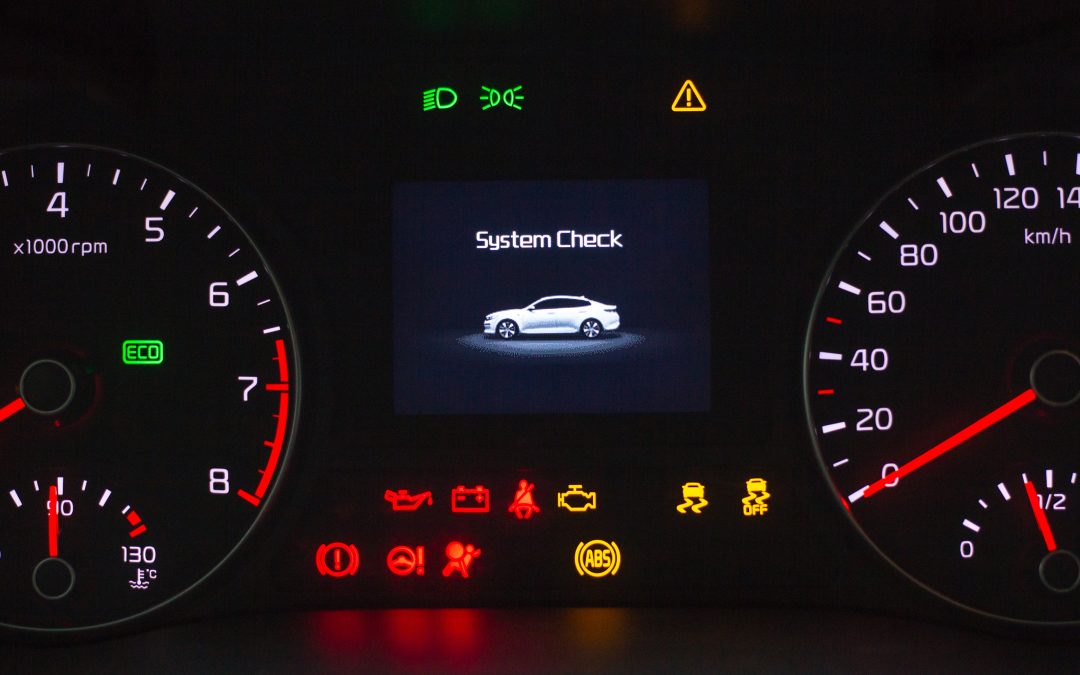Your car’s dashboard lights are more than just indicators – they’re your vehicle’s way of telling you something’s up.
It’s completely normal for a few lights to flash on briefly when you start the engine. But if any stay on while you’re driving, it’s time to take action.
As a general guide:
🔴 Red warning lights mean immediate attention is required – stop as soon as it’s safe.
🟠 Amber, orange or other colours typically signal something that needs checking – don’t ignore them, give us a ring.
Below is a quick guide to the most common dashboard lights our technicians get asked about. Tap into the sections below to learn what each symbol means. Can’t find your warning light? Check your vehicle’s handbook – icons vary between manufacturers.
Engine Management Light (Check Engine Light)
Can you keep driving?
✅ Yes – if the light is steady and there’s no loss in performance, it’s usually safe to carry on, but get it looked at soon.
❌ No – if it’s flashing while you drive. This could cause damage if ignored.
What to do next:
Ease off the accelerator, avoid high revs, and stop safely when you can. Switch off the engine, wait two minutes, then restart. If the light continues to flash, switch off again and call us.
What’s going on?
Modern vehicles are fitted with sensors feeding data to the engine control unit (ECU). If something’s wrong, the ECU triggers the warning light. The issue could range from a minor sensor fault to something more serious – best to have us investigate.
Battery Warning Light
Can you keep driving?
❌ No – if this red light appears while driving, it means your battery isn’t charging properly.
What to do next:
Find a safe spot to stop, turn off the engine, and don’t attempt to restart it. Call your breakdown provider.
What’s going on?
The fault could be with the battery itself, the alternator, or its drive belt. Ignoring it could leave you stranded.
Oil Pressure Warning Light
Can you keep driving?
❌ No – stop immediately. This light signals dangerously low oil pressure.
What to do next:
Safely pull over, check the oil level, and top up if it’s low. Refer to your owner’s manual for guidance. If the light remains on after topping up, switch off the engine and seek help.
What’s going on?
If oil levels are fine but the light’s still on, the issue could lie with the pump or a clogged filter. Running an engine without sufficient oil pressure can lead to major damage.
Brake Warning Light
Can you keep driving?
❌ No – if your brake pedal feels soft or travels further than usual, there could be a failure in the brake circuits.
✅ Yes – if the brake fluid is at the correct level, the issue may just be a faulty sensor.
What to do next:
First, check that the handbrake is fully released. Then inspect the brake fluid and top up if needed. If unsure, consult your handbook.
What’s going on?
You might have a fluid leak, worn brake pads or a faulty sensor. If in doubt, get professional help.
ABS Warning Light (Anti-lock Braking System)
Can you keep driving?
✅ Yes – usually safe if there are no strange noises or sensations. Still, drive carefully, especially in poor weather.
What to do next:
Book your vehicle in with us to have the ABS system checked as soon as possible.
What’s going on?
It could be a simple sensor issue, but ignoring it could reduce your car’s braking performance when it matters most.
Brake + ABS Warning Lights Together
Can you keep driving?
❌ No – pull over safely and call your breakdown provider.
What to do next:
Reduce your speed gradually and avoid sharp braking.
What’s going on?
This combination usually points to a serious brake fault. It’s unsafe to continue driving – get it checked immediately.
Diesel Particulate Filter (DPF) Warning Light
Can you keep driving?
✅ Yes – if the light comes on, drive at over 40mph for around 10 minutes to try and clear the filter.
❌ No – if the warning doesn’t clear, stop, turn off the engine and seek help.
What to do next:
Avoid frequent short trips and slow traffic where possible. Refer to your manual for model-specific guidance on regenerating the DPF.
What’s going on?
The DPF captures harmful soot particles and burns them off during high-temperature runs. If your driving style doesn’t allow this, the filter can become clogged – leading to reduced performance and costly repairs if left unresolved.
Think Your Vehicle’s Due a Check-Up?
Don’t wait for something to go wrong. If any of these signs sound familiar, book in with Segensworth Automobiles today.
Call us on 01489 662 000 or
